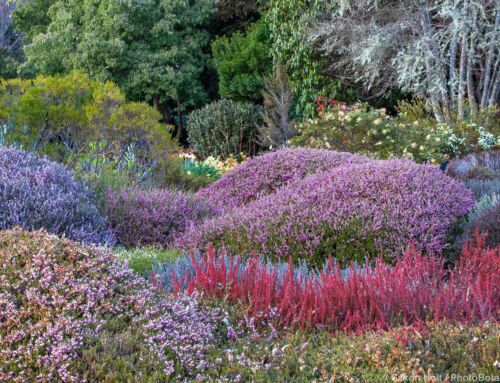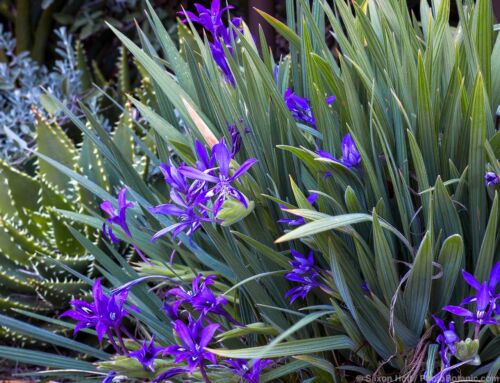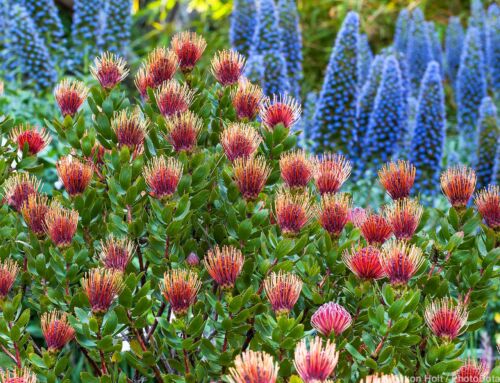
Arbutus unedo ‘Elfin King’ with fruit.
With evergreen, leathery, dark green leaves, showy clusters of tiny white spring flowers, small red berries in fall, and red-brown peeling bark, Arbutus menziesii is a signature tree of western North America. Native to coastal evergreen forests from southern British Columbia to California, the western slopes of the Sierra Nevada, and the eastern slopes of the Coast Ranges, this tree has long been considered too difficult for most cultivated landscapes. Commonly known as Pacific madrone, A. menziesii is available in small containers mostly from specialty nurseries and at native plant sales.
For best results, Arbutus menziesii should be set out in its permanent spot when the seedling is a foot or so tall. Excellent drainage is essential. Young trees seem to prefer the filtered shade of evergreen trees, but may not establish in full shade. They thrive in full sun along the coast and inland at higher elevations. Water only to establish and do not fertilize. Water and fertilizer will promote growth but make this plant more susceptible to disease. Usually slow-growing to anywhere from fifteen to fifty feet tall, trees may reach over 100 feet at great age.

Arbutus unedo (strawberry tree) by gravel pathway with ornamental grasses
Arbutus unedo, strawberry tree, is native to the Mediterranean Basin and parts of western Europe. With evergreen, leathery, dark green leaves, drooping clusters of small rosy white flowers, largish red fruits, and peeling reddish brown bark, strawberry tree is similar in many ways to Pacific madrone but much more tolerant of garden conditions. It grows in sun or shade and most soils and accepts some summer irrigation as long as drainage is adequate. Where content, it can reach fifteen to thirty feet tall and almost as wide.
Cultivated varieties of Arbutus unedo are common in the nursery trade. ‘Elfin King’ is a compact shrub with denser branching and somewhat slower growth than the species. ‘Compacta’ is said to be similar, reaching six to ten feet tall and wide at maturity.
Arbutus ‘Marina’ is a fairly large tree (forty feet tall and thirty feet wide at maturity) that looks enticingly small in fifteen-gallon containers. You will see it planted five feet from a building wall in new landscapes. In such situations you can be sure it will outgrow its allotted space and over time will require quite brutal pruning or removal.
‘Marina’ is often promoted as a garden-tolerant equivalent of Arbutus menziesii, and it is somewhat more accepting of typical garden conditions – a bit of summer water, less than perfect drainage, and clay soils. But it won’t take as much abuse as commonly assumed, especially excess irrigation or poorly drained soil. It is also best planted in a spot that can feature rather than fight the shedding of bark, fruits, and large leaves, which, as with most strawberry trees, is pretty much continuous.





Where can I get an Elfin King srubb?
If you can’t order ‘Elfin King’ through your local nursery, you might try looking for ‘Compacta’, which is also a smaller shrub. If you are in northern California, Cal Flora Nursery in Fulton sometimes has ‘Compacta’. Call first to be sure it is currently in stock.